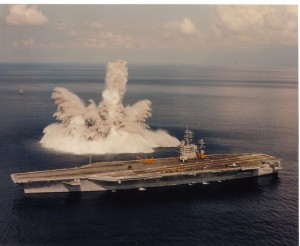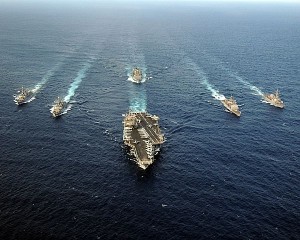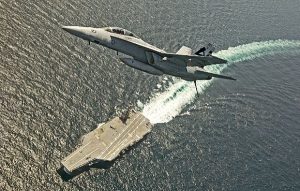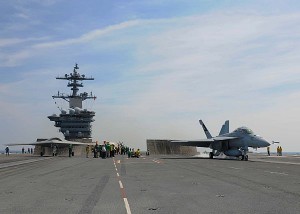 America has a very small window of time to shock test a Ford Class aircraft carrier. If missed, the Ford Class will likely not be shocked at all–a perplexing oversight as America “girds” anew for conventional state-state conflict.
America has a very small window of time to shock test a Ford Class aircraft carrier. If missed, the Ford Class will likely not be shocked at all–a perplexing oversight as America “girds” anew for conventional state-state conflict.
I am worried. Recent Ford shock trial coverage suggests American maritime commentators forget that the USS Nimitz (CVN 68) and the USS Dwight D Eisenhower (CVN 69) retirement dates are only two years apart (the FY 2019 thirty-year shipbuilding plan says 2025 for Nimitz and 2027 for Eisenhower). This—among other factors—risks sparking a mid 2020’s “carrier panic” where Full Ship Shock Trial (FSST) waivers will be easy to come by.
Pushing the shock trial back six years to “at least” 2024/5 will reportedly get the USS Ford (CVN 78) on her first deployment a tad earlier, in “2019 to 2020”. That’s optimistic. Without an FSST, the incomplete Ford will likely claw back a mere year of service life, going to sea sometime between late 2020 or 2021 rather than the currently scheduled date of 2022. But it’ll keep Ford problems out of the headlines and out of President Trump’s crosshairs until it is too late for the President to mess with the program. And the Navy will get a two ship block-buy out of it, too. So everybody wins, right?
Right.
 Prepare For the Carrier Panic of 2024-6
Prepare For the Carrier Panic of 2024-6
Kicking back the FFST “at least” six years lands this year-long testing/repair regimen right into the midst of what will be America’s first carrier panic. Between 2024-6, CVN 68 will be gone, CVN 69 will be well on the road to hulk-ville, CVN 76 will be in ROCH, USS Ford (CVN 78) will still (STILL !!) be a partially-complete test-bed, a newly-delivered USS John F. Kennedy (CVN 79) will be sidelined for testing and the other Navy carriers will be breaking down under the weight of years of increased demand/warfighting contingencies. In short, if America thinks it has CVN deployment problems now…it sure doesn’t get any better six years from now. There’s no way the Navy (or a pliant Congress) will carry out a shock trial for the new USS John F. Kennedy (CVN 79). The FSST won’t happen.
By 2024-6 America will be in a carrier crisis. China will have a number of carriers with proficient crews (I have long said that they’ll follow a similar process as we did, rushing 4-5 big carriers into commission just to push a panicked U.S. into poor strategic decision-making), and America–at the rate things are going–won’t have a strategy ready to tolerate a large number of freely-roaming, independently-minded Chinese battle groups that, uh, will act just like their American brethren (Who out there can wait for America’s reaction to the PLA(N)’s first “Grenada with Chinese Characteristics“!).
Making matters worse, the first Columbia Class SSBNs will just be getting procured, ushering in a decade of a hollowed-out Navy budget. In that cost-constrained and panicky environment, nobody will want to hear about taking a brand-new carrier off-line for a pricey shock trial and repairs (repairs that will need to flow back to the USS Ford and forward into any other Fords we procure).
Forgoing the FY2019 shock trials does reduce procurement risk—negotiations to accelerate procurement of CVN 81 or a block buy/combined material buy of CVN 80 and 81 can proceed without risk of “bad news” from a poorly-tolerated shock trial.
But this delay does say to me that the Navy lacks confidence and that the Ford Class is fragile, unlikely to tolerate battle damage well. And sailors risk being saddled with four fragile Fords, with crews unaware of potential dangers and risks should those vessels need to travel into harm’s way.
Maybe the great aircraft carrier admirals like Halsey or Nimitz would appreciate the political symbolism of rushing to send the incomplete USS Ford out on patrol in time for the 2020 election season, and would understand the importance of keeping the Ford Class carrier program out of the line of fire from an erratic “God D### Steam” White House. From a bureaucratic standpoint, it’s understandable–If I were part of the Ford Program Office, I’d sure fear the response if the White House heard bad news about the Ford’s shock trial. But from sailor safety and warfighting standpoint, such cowardice is incomprehensible.
Where has the Navy’s swashbuckling “Damn the torpedoes” spirit gone? Shock the Ford.
 An Un-shocked Ford Won’t Patrol Early
An Un-shocked Ford Won’t Patrol Early
Let’s be honest. Pushing back the shock trial will not get the USS Ford to sea early. Everyone knows the USS Ford isn’t ready for prime time. Any talk of a 2019 patrol is, at best, disingenuous twaddle shopped to credulous defense reporters. USS Ford might be ready for patrol by 2020 at the very absolute earliest, and I strongly suspect that the USS Ford’s first deployment will “slide right” towards it’s currently-scheduled 2022 cruise date anyway.
There’s just too much to do.
First, to become a full-up battle-ready tool, the Ford needs hundreds of millions of dollars to officially “complete”. A lot can get done during the Ford’s 2019 PSA, but the odds are that the Ford will need far more yard time than advertised. And then the crew will need to test, train and qualify on the new gadgets. That all takes time.
Second, EMALS/AAG is coming along, but progress is slow. When spokesman extraordinaire Captain Danny Hernandez proudly said earlier this year that “The carrier has completed six under-way events and conducted over 700 catapult launches and arrestments with navy jets [F/A-18E/F aircraft], including over 100 launches and recoveries in one day on two separate occasions,” I have written about this sort of participation award language before, but I can’t help but recall that USS George Bush (CVN 77) completed almost as many catapult launches and arrestments (695) on the carrier’s first ten-day cruise.
Until the USS Ford demonstrates a capability to regularly launch and recover full carrier strikes day-in and day-out, the Ford Class is little more than a 13-billion dollars-a-hull research project.
The third challenge is the air wing. The air wing won’t be complete until 2020 at the earliest. As I have written before, the Ford won’t be set to safely launch E-2Ds and fully-loaded Super Hornets until after the Ford’s 2019 PSA. That’ll be a fix that’ll take months to work through and certify, which, in turn, pushes the Ford’s first deployment out to 2020 and 2021. Nobody out there has mentioned the Ford’s capability to launch and recover C-2s either, so in the event the old COD resupply aircraft aren’t being programmed into the EMALS/AAG system, the carrier will be dependent upon Boeing’s CMV-22 “Codsrey”. They’re set to be fielded in 2020-2021. And then there’s the F-35C. The first operational F-35C squadron is set to enter the fleet in 2021 too. I presume the Navy will be pressed to put their newest aircraft aboard their newest carrier’s first combat tour.
With all this new hardware headed to decks in 2020/1, there is no way the Navy will want to take one of it’s precious EMALs carriers out of circulation for a 2024/5 shock trial. Not only will the new F-35Cs be entering the fleet in numbers, but the MQ-25 Stingray will be making it’s first tentative steps into service. I fully trust the Admirals will want to play with all their new toys on all their newest carriers.
 Conclusion:
Conclusion:
Certainly, there are a lot of moving parts and industrial base considerations that go into carrier scheduling. There are plenty of compelling things are informing the Navy’s efforts to squirm out of an FY 2019 shock trial (hell, the USS Ford isn’t even a complete vessel yet! And America only has a single Ford-ready dry-dock on the East Coast–and it’s fully booked for the decade!), but it is somewhat deceptive to cite carrier force levels as a justification to delay shock trial tests when the relative strength of America’s carrier fleet is stronger now, today, than it will ever be in the coming decade. But if America’s Navy has a shred of confidence in their new carrier class, or the quality of American naval engineering and shipbuilding….then they should “damn the torpedoes” and shock the USS Ford now, today.
And then….maybe, just maybe….America should consider shocking any one of the multiple flavors of the Virginia Class nuclear attack submarine–Because I’m shocked (shocked!) that America’s front-line subs waived their way through FSSTs. Computers are great, but nothing compares to real-world testing. Let’s get it done.

{ 7 comments… read them below or add one }
You’re right, it wont happen.
The simple reason i see for this is, that no Admiral of a sufficiently senior rank actually believes any of his carriers will ever need to face a near peer opponent, rather, the carrier will force will continue being trailer queens, used as diplomatic tools, flying the flag in foreign ports, occasionally partaking in colonial warfare against 3rd rate militaries, rather than actual tools of warfare.
If you think theres a single elected politician serving in the US senate or house who would gainsay such stupidity, you’re whistling dixie.
The US fully expects to never have to face down a serious opponent militarily ever again. Its military procurement shows that above all else. Its cyber warfare departments aren’t much better, even though thats the only realm we’re realistically ever going to wage war in against serious opponents.
Its understandable thinking really. What potential military rival could wage a war against the west that wouldn’t end up with an exchange of nukes should one side look likely to lose?
To be a trifle cynical, the argument for a quick order of a set of CVF’s modified for traps and cats get stronger by the day. After all, how many of those can we get for a single Ford? Several at least, including redesign costs.
Yeah, the case for smaller carriers gets pretty simple when the large carrier doesn’t really work. I’m still stunned we didn’t build-in a floating prototype–if all the electromagnetic stuff is scalable (as boosters claim), why didn’t we add this gear to one of the aviation-focused LHDs and use it to fire off UAVS or something?
Sounds like crazy talk to me. Next you’ll be suggesting having a dedicated training carrier, or adding ski-ramps to the America class.
Case for a smaller carrier also improves when the big carriers don’t deploy with anything like their full aircraft capacity in which case you are essentially taking an RV to the cornershop. I’ll be interested to see how the crew numbers for CVF work out. They are a lot lower than for US carriers, even allowing for reduced size of vessel and air complement.
As for shocking the ship, getting an understanding of how EMALS responds to being shocked seems like it would be a high priority. The more so given recent suggestions that the system is difficult to repair at sea, let alone maintain operations and repair at sea.
Yeah…it’s interesting to hear complaints about how America’s risk-aversion is delaying things in certain fields, when, over here in naval shipbuilding, the Navy is absorbing a $13-billion dollar bundle of risk with little more than a resigned shrug.
I know this post is about shock testing, but I was wondering more about the aircraft. Given the catapult still doesn’t work, from what I can read online, I wonder if the Fords will end up operating a lot of F35B’s, which don’t need it. Several Nimitz Class carriers will be removed from service in a few years as written above, so if the carrier doesn’t work, what runarounds are there, besides using the F35B?
I’m sure the Ford will be able to launch and recover aircraft–just not at the rate originally used to justify the vessel. And, you know, who knows what this new technology will mean for UAVs. Fords might be an awesome platform for UAVs…we just don’t know yet. …